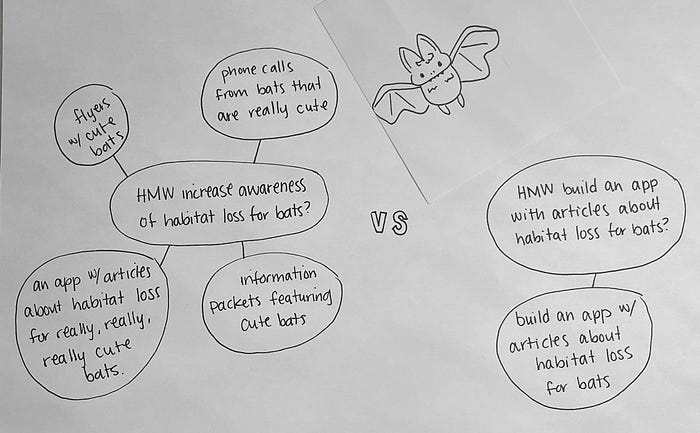
Getting batty about How Might We questions
This article is day 3 of a 31 day series. A mash-up of the Inktober 2022 prompt list and UX terminology. Read more about the challenge here.
Day 3 | Inktober prompt: Bat | UX Term: How Might We
Bats might not need light, but you do, so flip a switch!
Every good UX design project will start with some form of discovery. In Design Thinking we call this the “Empathize” phase. It’s a period of uncovering insights about the problem you’re solving for. When you’ve gathered insights during your research, you need a way to further synthesize that information into useful next steps.
Speaking of next steps, did I mention that I love bats? (Sorry that’s the best segue I could come up with on short notice.) I grew up visiting Carlsbad Caverns, and now live in Austin, TX, home of the largest urban bat colony in the world. Granted proximity alone does not make you love something. But their cute little faces sure do!
What is a How Might We question?
We use How Might We questions (often called by their initialism HMW), to begin brainstorming possible solutions. For this reason it’s important that the HMW questions do not provide a solution.
Let’s say we’re looking to solve the problem of habitat loss for bats in the US. We’ve done our research and gathered insights, and we’re thinking that increased awareness of the problem could be the solution to making a difference. Now we’d like to begin our HMW brainstorming session.
Good example: How might we increase awareness of habitat loss for bats?
Bad example: How might we build an app with articles about habitat loss for bats?
In our good example we could come up with a laundry list of possible solutions: flyers with cute bats on them, information packets featuring cute bats, phone calls from bats that are really cute, an app with articles about habitat loss for really really really cute bats… and on and on.
With our bad example we have one solution: an app with articles about habitat loss for bats.

Why is it important to UX?
In UX it is important to never ever, no never, start with a solution. We are in the business of solving problems. But like, really solving them. If you start immediately listing off solutions, it’s like receiving unsolicited advice. While it may be well intentioned, it just doesn’t have the data or insight to be useful.
How do you make one?
Now imagine you’re a bat, complaining about habitat loss to a cave-mate because sometimes being a bat is hard, and you just want to complain to someone. This super sweet bat friend then tells you that you should just quit being a bat and start your life as a house cat. After all they care about you and want you to be happy.
But is that really problem solving? If the end result would be you living in an unfamiliar place without your friends and family, and eating tuna instead of delicious insects, I’m thinking… no.
Instead, take your insights in the form of “How might we…” questions and follow these six steps.
- Write your HMW question in the center of a page and circle it.
- Set a timer for 1–3 minutes.
- Brainstorm possible solutions written as offshoots of your HMW question until the timer goes off.
- Repeat steps 1–3 for any remaining HMW questions.
- Go back to your first HMW question and brainstorm for 1 additional minute.
- Do the same for the remaining HMW questions.
I typically will approach this exercise with two rounds because by the time you’re wrapping up your last one, your wheels are really turning, and giving yourself one more minute to explore each one can give great returns.
Step 7 would then be to review all of your brainstorming ideas and begin to identify patterns. These patterns will show you the ideas that will have an impact on multiple problems, so they should be added to your short list.
Takeaway
The main takeaway here is that bats are really cute and worth saving. But you already knew that. What I hope you learned was how valuable it can be to stop thinking of solutioning as a first step. By focusing on the problem to be solved, and leveraging the benefits of How Might We exercises, you’ll improve your user experience, and you might just get to stay in your cave after all.
During my research I stumbled upon many great groups looking to make a difference for the bat population in the US and around the world. One in particular stood out. If you’re looking to find ways to help, I recommend checking out Bat Conservation International to learn more about their mission and efforts.
